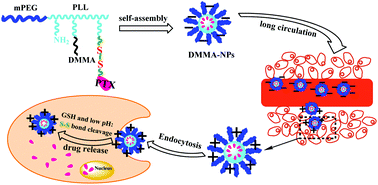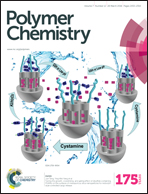A charge-conversional intracellular-activated polymeric prodrug for tumor therapy
Abstract
Stimuli-responsive drug-delivery systems have attracted great attention for controlled drug release. The pH value is relatively low in the tumor tissues and the concentration of glutathione is significantly high in the cells. According to these features, a charge-conversional polymeric prodrug that is sensitive to pH and redox is designed. 3,3′-Dithiodipropionic acid modified paclitaxel (DTPA-PTX) and 2,3-dimethylmalefic anhydride (DMMA) are conjugated to the amino groups of poly(ethylene glycol)-b-poly(L-lysine) (mPEG-b-PLL). The surface charge of the obtained mPEG-b-(PLL-co-(PLL-DMMA)-co-(PLL-DTPA-PTX)) nanoparticles (DMMA-NPs) can change from negative at blood pH to positive at tumor extracellular pH, implying that the DMMA-NPs will have a prolonged blood circulation time through avoiding rapid clearance by the reticuloendothelial system and an enhanced cell uptake at the tumor site. Compared to the control group, the in vitro studies show that the DMMA-NPs exhibit effective cellular uptake, rapid intracellular drug release, and significantly enhanced cytotoxicity against MCF-7 tumor cells, owing to the tumor-relevant pH and reductive conditions. These indicate that the charge-conversional DMMA-NPs provide an excellent platform for potential tumor therapy.


 Please wait while we load your content...
Please wait while we load your content...